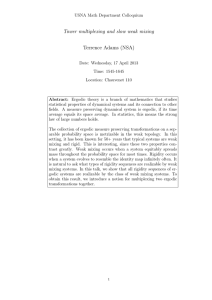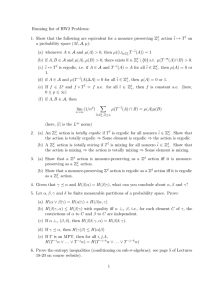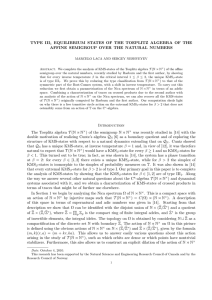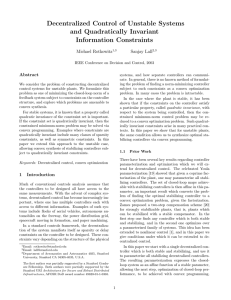Ergodicity of the action of the positive rationals on
advertisement
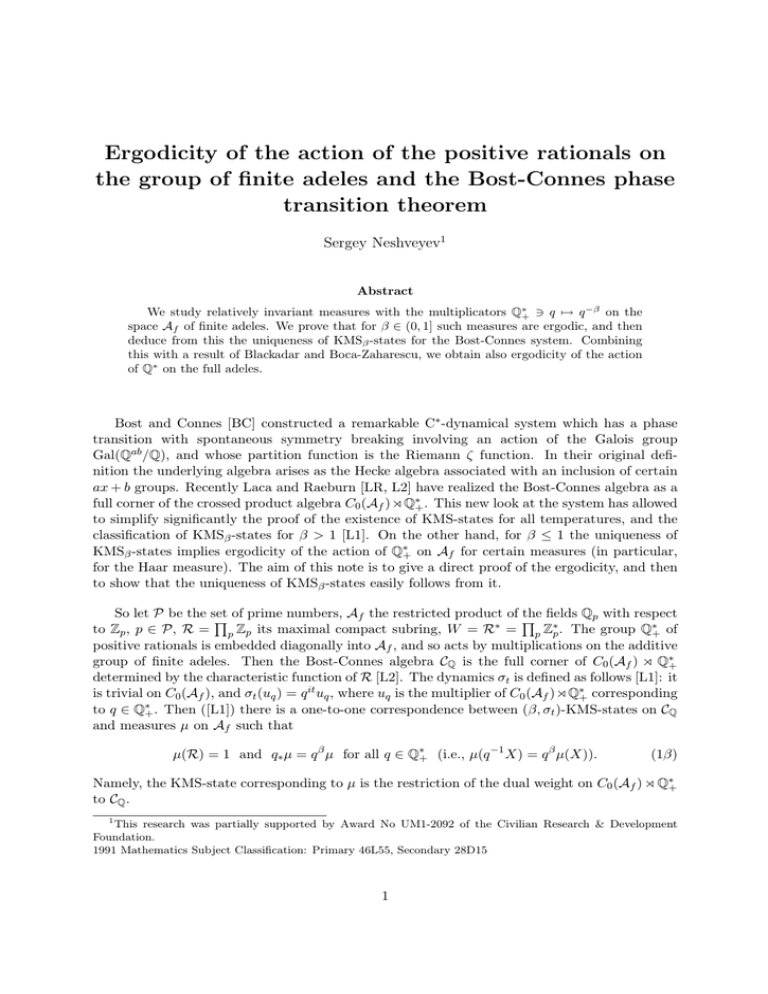
Ergodicity of the action of the positive rationals on
the group of finite adeles and the Bost-Connes phase
transition theorem
Sergey Neshveyev1
Abstract
We study relatively invariant measures with the multiplicators Q∗+ 3 q 7→ q −β on the
space Af of finite adeles. We prove that for β ∈ (0, 1] such measures are ergodic, and then
deduce from this the uniqueness of KMSβ -states for the Bost-Connes system. Combining
this with a result of Blackadar and Boca-Zaharescu, we obtain also ergodicity of the action
of Q∗ on the full adeles.
Bost and Connes [BC] constructed a remarkable C∗ -dynamical system which has a phase
transition with spontaneous symmetry breaking involving an action of the Galois group
Gal(Qab /Q), and whose partition function is the Riemann ζ function. In their original definition the underlying algebra arises as the Hecke algebra associated with an inclusion of certain
ax + b groups. Recently Laca and Raeburn [LR, L2] have realized the Bost-Connes algebra as a
full corner of the crossed product algebra C0 (Af )oQ∗+ . This new look at the system has allowed
to simplify significantly the proof of the existence of KMS-states for all temperatures, and the
classification of KMSβ -states for β > 1 [L1]. On the other hand, for β ≤ 1 the uniqueness of
KMSβ -states implies ergodicity of the action of Q∗+ on Af for certain measures (in particular,
for the Haar measure). The aim of this note is to give a direct proof of the ergodicity, and then
to show that the uniqueness of KMSβ -states easily follows from it.
So let P be the set
of Q
the fields Qp with respect
Q of prime numbers, Af the restricted product
∗
to Zp , p ∈ P, R = p Zp its maximal compact subring, W = R = p Z∗p . The group Q∗+ of
positive rationals is embedded diagonally into Af , and so acts by multiplications on the additive
group of finite adeles. Then the Bost-Connes algebra CQ is the full corner of C0 (Af ) o Q∗+
determined by the characteristic function of R [L2]. The dynamics σt is defined as follows [L1]: it
is trivial on C0 (Af ), and σt (uq ) = q it uq , where uq is the multiplier of C0 (Af )oQ∗+ corresponding
to q ∈ Q∗+ . Then ([L1]) there is a one-to-one correspondence between (β, σt )-KMS-states on CQ
and measures µ on Af such that
µ(R) = 1 and q∗ µ = q β µ for all q ∈ Q∗+ (i.e., µ(q −1 X) = q β µ(X)).
(1β)
Namely, the KMS-state corresponding to µ is the restriction of the dual weight on C0 (Af ) o Q∗+
to CQ .
1
This research was partially supported by Award No UM1-2092 of the Civilian Research & Development
Foundation.
1991 Mathematics Subject Classification: Primary 46L55, Secondary 28D15
1
Q
Note ([L1]) that if β > 1 and µ is a measure with property (1β) then µ(W ) = p∈P (1 −
1
p−β ) = ζ(β)
> 0, since W = R\ ∪p pR. Moreover, the sets qW , q ∈ Q∗+ , are disjoint, and their
P
1 P
−β = 1). Thus there exists a
union is a set of full measure (since n∈N µ(nW ) = ζ(β)
n∈N n
one-to-one correspondence between probability measures on W and measures on Af satisfying
(1β) [L1]. On the other hand, if β ≤ 1 then µ(W ) = 0.
Proposition. For β ∈ (0, 1] and any measure µ satifying (1β), the action of Q∗+ on (Af , µ) is
ergodic.
Proof. Consider the space L2 (R, dµ) and the subspace H of it consisting of the functions
that are constant on N-orbits. In other words, H = {f ∈ L2 (R, dµ) | Vn f = f, n ∈ N},
where (Vn f )(x) = f (nx). Since any Q∗+ -invariant subset of Af is completely determined by its
intersection with R, it suffices to prove that H consists of constant functions. For this we will
compute the action of the projection P : L2 (R, dµ) → H on functions spanning a dense subspace
of L2 (R, dµ).
Q
Let B be a finite subset of P. Consider the projection πB : R → p∈B Zp , and set µB =
Q
(πB )∗ µ. Then L2 ( p∈B Zp , dµB ) can be considered as a subspace of L2 (R, dµ), and the union
Q
of these subspaces over all finite B is dense in L2 (R, dµ). The characters of p∈B Z∗p span a
Q
dense subspace of L2 ( p∈B Z∗p , dµB ). Let
the unital multiplicative subsemigroup of N
Q NB be
∗
generated
by p ∈ B. Note that the sets n p∈B Zp , n ∈ NB , are disjoint, their union is a subset of
Q
Z
of
full measure (condition (1β) implies that the set {x ∈ R | xp = 0} has zero measure),
p
p∈B
Q
Q
∗ , dµ ) onto L2 (n
∗
and the operator n−β/2 Vn∗ maps isometrically L2 ( p∈B ZQ
B
p
p∈B Zp , dµB ) for
∗
∗
any n ∈ NB . Hence the functions Vn χ, n ∈ NB , χ ∈ ( p∈B Zp )ˆ, span a dense subspace of
Q
L2 ( p∈B Zp , dµB ). So we have to compute P Vn∗ χ. But if g ∈ H then (Vn∗ χ, g) = (χ, g), whence
P Vn∗ χ = P χ. Thus we have only to compute P χ.
For a finite subset A of P, let HA be the subspace consisting of the functions that are
constant on NA -orbits, PA the projection onto HA . Then PA & P as A % P. Set
Y
Y
WA =
Z∗p ×
Zq ⊂ R.
p∈A
q∈P\A
Note, as above, that ∪n∈NA nWA is a subset of R of full measure. We assert that
X
1
PA f |NA x ≡
n−β f (nx) for x ∈ WA ,
ζA (β)
(2)
n∈NA
P
Q
where ζA (β) = n∈NA n−β = p∈A (1 − p−β )−1 . Indeed, denoting the right hand part of (2)
by fA , for g ∈ HA we obtain
Z
X Z
X
−β
(fA , g) =
fA (x)g(x)dµ(x) =
n
fA (x)g(x)dµ(x)
n∈NA
nWA
= ζA (β)
fA (x)g(x)dµ(x) =
WA
=
X Z
n∈NA
WA
n∈NA
Z
X
n∈NA
n−β
Z
f (nx)g(x)dµ(x)
WA
f (x)g(x)dµ(x) = (f, g).
nWA
Returning to the computation of P χ, we see that
PA χ|NA x ≡
Y 1 − p−β
χ(x) X −β
n χ(n) = χ(x)
for x ∈ WA .
ζA (β)
1 − χ(p)p−β
p∈A
n∈NA
2
(3)
Hence
Y 1 − p−β kP χk2 = lim
1 − χ(p)p−β .
A%P
(4)
p∈A
Q
If χ is trivial, then using (3) we see that PA χ ≡ p∈B (1 − p−β ) for all A ⊃ B, hence P χ
is a constant. Suppose χ is non-trivial. The limit in (4) is an increasing function in β on
(0, +∞) (because
each factor is increasing), which is equal to |L(β, χ)|ζ(β)−1 for β > 1, where
P∞
L(β, χ) = n=1 χ(n)n−β is the Dirichlet L-function corresponding to the number character χ [S].
By elementary properties of Dirichlet series, |L(β, χ)| tends to a finite value as β → 1 + 0, while
ζ(β) → ∞. Thus P χ = 0.
Since the set of measures satisfying (1β) is convex and consists of ergodic measures, there
exists at most one measure satisfying (1β). Such a measure does exist. In fact, for each β ∈
(0,
Q +∞) there is a unique W -invariant measure µβ satisfying (1β) [BC, L1]. Explicitly, µβ =
p µβ,p , where µβ,p is the measure on Qp such that µ1,p is the Haar measure (µ1,p (Zp ) = 1), and
dµβ,p
1 − p−β β−1
(a) =
|a|
for a ∈ Qp .
dµ1,p
1 − p−1 p
Let φβ be the (β, σt )-KMS state on CQ corresponding to µβ . Then πφβ (CQ )00 is a factor, which
is a reduction of the factor L∞ (Af , µβ ) o Q∗+ . It is easy to describe its flow of weights [CT].
Consider a standard measure space Xβ with the measure algebra consisting of Q∗+ -invariant
(λ × µβ )-measurable subsets of R+ × Af , where λ is the Lebesgue measure, and the flow Ftβ
on it coming from the action t(x, a) = (e−t/β x, a) of R on R+ × Af . Then Ftβ is ergodic by
Proposition, and it is the flow of weights of the factors L∞ (Af , µβ ) o Q∗+ and πφβ (CQ )00 .
Theorem.[BC] For β ∈ (0, 1], µβ is a unique measure satisfying (1β). The action of Q∗+ on
(Af , µβ ) is ergodic, moreover, the action of Q∗ on (A, νβ ), where A = R × Af is the space of
full adeles and νβ = λ × µβ , is ergodic. Equivalently, φβ is a unique (β, σt )-KMS state on CQ ,
and πφβ (CQ )00 is the hyperfinite factor of type III1 .
Proof. In view of the above description of the flow of weights, the factor πφβ (CQ )00 is of type III1
if and only if the action of Q∗+ on (R+ × Af , λ × µβ ) is ergodic, or equivalently, the action of Q∗
on (A, νβ ) is ergodic.
To prove the ergodicity, first note that the action of W on Xβ is ergodic. Indeed, the induced
flow on Xβ /W is the flow of weights of the factor
L∞ (Af /W, µβ ) o Q∗+ = (L∞ (Af , µβ ) o Q∗+ )W .
It is easy to see ([BC]) that this factor is ITPFI with eigenvalue list {p−nβ (1 − p−β ) | n ≥ 0}p∈P .
Hence it is of type III1 by [B] (see also [BZ]). Thus its flow of weights is trivial, i.e. the action
of W on Xβ is ergodic. Since W is compact, the action is transitive. So we may identify Xβ
with W/Wβ for some closed subgroup Wβ of W . Then the flow Ftβ is given by a continuous
one-parametric subgroup of W/Wβ . Since W/Wβ is totally disconnected, this one-parametric
subgroup is trivial, and since the flow is ergodic, Wβ = W . Thus Xβ is singlepoint, and the
action of Q∗+ on (R+ × Af , λ × µβ ) is ergodic.
Remarks.
(i) In order to prove that φβ is a unique KMSβ -state, it is enough to know that µβ is ergodic.
3
Indeed, this means that φβ is an extremal KMSβ -state. Since φβ is a unique W -invariant KMSβ state,
we can argue as in the proof of [BC, Theorem 25]: If ψ is an extremal KMSβ -state, then
R
w
ψ
W ∗ dw = φβ . Since KMSβ -states form a simplex, we conclude that ψ = φβ .
Thus, the uniqueness and the assertion about the type for KMSβ -states follow easily from
ergodicity of the action of Q∗ on (A, νβ ).
(ii) A slight modification of the argument in the proof of Theorem gives the following general
result, apparently well-known to specialists: if M is a factor, G a compact totally disconnected
group acting on M such that M G is a factor of type III1 , then M is also of type III1 .
Acknowledgement. The author is grateful to Marcelo Laca, Sergey Sinelshchikov and
Yoshimichi Ueda for helpful discussions.
References
[B] Blackadar B., The regular representation of restricted direct product groups, J. Func. Anal.
25 (1977), 267–274.
[BZ] Boca F.P., Zaharescu A., Factors of type III and the distribution of prime numbers, Proc.
London Math. Soc. 80 (2000), 145–178.
[BC] Bost J.-B., Connes A., Hecke algebras, type III factors and phase transitions with spontaneous symmetry breaking in number theory, Selecta Math. (New Series) 1 (1995), 411–457.
[CT] Connes A., Takesaki M., The flow of weights on factors of type III, Tôhoku Math. J. 29
(1977), 473–575.
[L1] Laca M., Semigroups of *-endomorphisms, Dirichlet series, and phase transitions, J. Func.
Anal. 152 (1998), 330–378.
[L2] Laca M., From endomorphisms to automorphisms and back: dilations and full corners, J.
London Math. Soc. 61 (2000), 893–904.
[LR] Laca M., Raeburn I., A semigroup crossed product arising in number theory, J. London
Math. Soc. 59 (1999), 330–344.
[S] Serre J.-P. Cours d’arithmétique. P.U.F. Paris, 1970.
Institute for Low Temperature Physics & Engineering
47 Lenin ave
Kharkov 310164, Ukraine
neshveyev@ilt.kharkov.ua, neshveyev@hotmail.com
4

